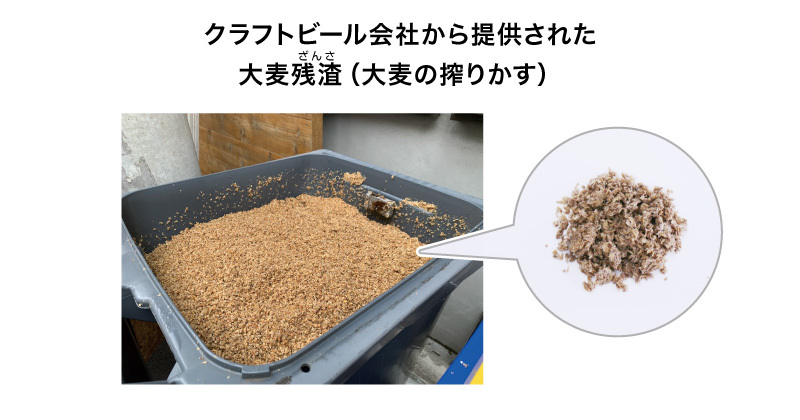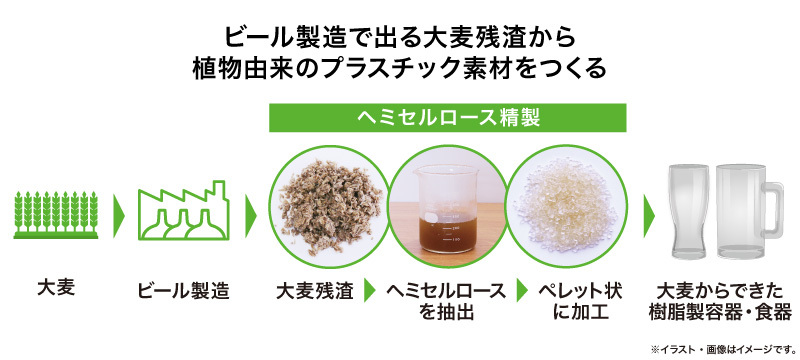Seven companies, led by Dentsu Group, are collaborating on the "SDGs Business Solutions" initiative ( release here ) to support corporate efforts in building a circular economy.
This time, we introduce the efforts of Dentsu Inc. Tech, a participant in the program. Dentsu Inc. Tech provides various solutions tailored to its client companies' promotional challenges and also handles product development.
Globally, the movement to reduce plastic use is accelerating. Plant-based materials are gaining attention as a way to contribute to reducing petroleum-derived plastics. Plastics made from various plants, such as corn and sugarcane, are emerging.
Amid this trend, Dentsu Inc. Tech focused on "barley residue" (the spent grain left after brewing beer). Why barley? What kind of plastic is made from barley residue? We spoke with Shingo Torato of Dentsu Inc. Tech, who spearheaded the initiative, and Hitoshi Nasukawa, President of Business Innovation Partners (*), the development partner.
*Business Innovation Partners: A venture company engaged in the research, development, and manufacturing of new bioplastic materials. It holds the distinction of being the first in the world to successfully develop bioplastic using hemicellulose, a major component of trees.

Even in the world of advertising and promotion, "environmentally conscious materials" are in demand!
─First, could you tell us about the societal movements surrounding plastic reduction and decarbonization? With the introduction of fees for plastic shopping bags and Prime Minister Kishida's decarbonization declaration, public interest is undoubtedly growing. But what about corporate actions and the current state of affairs?
Torawata: I believe companies, including advertisers, are definitely seeing a shift in their level of environmental concern. As the only promotion company within the Dentsu Group, Dentsu Tech handles everything from marketing strategy to execution, both online and offline. As part of this, we produce items like promotional goods. Starting around the latter half of 2019, we increasingly heard clients say, "We want you to use environmentally friendly materials."
For example, we started receiving more and more requests like, "Please make cups from non-petroleum-based materials," or "Please produce various event materials using environmentally friendly materials." Feeling this high demand was the catalyst that pushed us to take a step further into material development.
It's not uncommon for companies to have guidelines at the corporate level, not just project level, stating "We must not procure items unless they are environmentally conscious." Today, I feel that the use of environmentally friendly materials is encouraged by most of our client companies, including those in beverages, distribution, and life insurance.
Nasukawa: This movement is predicted to accelerate even further. The catalyst was the change in U.S. presidents from Trump to Biden. With the administration shift, policies on the economy and environment took a 180-degree turn, and the U.S. announced its re-entry into the Paris Agreement after previously withdrawing. This has triggered a global rush to develop environmentally friendly products.
Europe stands out globally for its advanced environmental initiatives. Europe has a deep-rooted culture of home composting, where household food waste is turned into fertilizer. This background has made it easier for understanding about moving away from plastic and decarbonization to spread. For consumers, choosing and buying products made with plant-based materials is now simply the norm. Therefore, companies naturally see it as their responsibility to develop environmentally friendly materials and use them in their products.
Torafuji: In Europe, environmentally friendly materials also seem to receive preferential treatment in terms of taxation, right?
Nasukawa: Yes. I believe they are about ten years ahead of Japan, both in terms of awareness and institutional frameworks. That means Japan is lagging behind by a decade. Riding the global wave, Japanese society and businesses have finally reached a point where they must get serious, albeit belatedly.
Barley residue generated daily in large quantities at beer factories
─Next, please tell us about this project. Dentsu Inc. Tech and Business Innovation Partners collaborated on a demonstration experiment to create plant-based plastic materials from barley residue. What prompted your focus on barley residue?
Torawata: As mentioned at the beginning, in recent years, our business has increasingly been required to use environmentally friendly materials. This led us to gather information and study plant-based plastic materials, and we learned that "sugar" is crucial for creating plant-based plastics.
When I thought, "What plants rich in sugar might hold potential?", the beverage manufacturer we work with on promotions immediately came to mind. I recalled hearing that the residue left after squeezing barley has a faint sweetness. "Couldn't the massive amounts of barley spent grain produced during beer manufacturing be a potential source...?" I thought. When I mentioned this to President Nasukawa, he responded, "That's great!" We decided to move forward with it as a collaborative project.
Nasukawa: The plant-based plastic material we handle, hemicellulose, has traditionally been sourced from trees like cedar and bamboo. Barley never crossed our minds. And it's generated in huge quantities as beer spent grain. Utilizing this would make for a highly eco-friendly and circular initiative. Mr. Torado's idea gave us a real epiphany – it was like scales falling from our eyes.
Furthermore, Torado-san presented our technology and the potential of barley residue to several beverage manufacturers he had connections with. He even found a company willing to cooperate on a proof-of-concept experiment.
Torawata: We went together to get the barley residue from a craft beer company, and we talked about all sorts of things while drinking beer, right? (laughs)
Nasukawa: Exactly. We were both a little tipsy, discussing ways to utilize hemicellulose and its future potential (laughs).
Our company is the only one in the world with the technology to develop bioplastics using hemicellulose as a raw material. We found a new path to utilize this technology more broadly and circularly. I remember feeling incredibly happy and passionate about that.

The barley residue left over from the brewing process has a faintly sweet taste when you put it in your mouth.
What exactly is "hemicellulose" derived from trees and barley?
─Please tell us about hemicellulose, the bioplastic material handled by Business Innovation Partners. Why can sugars found in plants become plastic? How does it differ from the commonly heard cellulose?
Nasukawa: Plants contain polysaccharides—components that are easy to process, heat-resistant, and even edible. By extracting these, applying heat, stretching them, or slightly rearranging their structure through chemical synthesis, we can create materials with plastic-like properties. Incidentally, polysaccharides are composed of C, H, and O in their chemical formula. In fact, plastics, whether derived from petroleum or plants, are also made up of C, H, and O. Because the basic molecular structure is the same, sugar can be turned into plastic.
Cellulose, a well-known plant-derived plastic material, is characterized by its high strength and hardness, making it suitable for building materials. However, it has the disadvantage of lacking fluidity, making it difficult to process. Hemicellulose, on the other hand, has lower strength but offers the advantage of being easier to process due to weaker molecular bonds and greater fluidity. Yet, research and development on hemicellulose alone has not progressed, leaving it globally underutilized as a resource.
By adding cellulose to hemicellulose, it becomes possible to create plastic products like cups that require a certain level of strength. Cellulose and hemicellulose are materials that can complement each other.
Torawata: For this project, we developed the process to extract hemicellulose from barley from scratch. While the technology to refine hemicellulose into biomass plastic is unique to Business Innovation Partners, I believe significant meaning lies in the extraction of the hemicellulose itself from barley. No other company or organization worldwide can extract this from plants and turn it into a material. Therefore, we had to trial and error something unprecedented. I imagine it was an immense challenge.
Nasukawa: That's right. For the extraction process, we repeatedly verified by changing factors like temperature, water volume, and pressure, searching for optimal values and running simulations. It was truly mind-numbing work, like searching for gold dust in the desert... Precisely because of that, we were overjoyed when the process was finally completed. We felt a tremendous sense of accomplishment.

Barley residue is an excellent raw material. It also holds potential for use in biomass power generation!
─Could you tell us about the potential of bioplastics using barley residue and future prospects?
Torawata: Moving forward, we aim to verify how many kilograms of bioplastic can be produced from barley residue and increase the yield (the percentage of bioplastic produced from a given amount of residue) even slightly. Higher yields not only make commercialization and monetization easier but, more importantly, make it easier for many companies to adopt. Then, I believe it will truly become a circular system, spreading rapidly and starting to function effectively. The current yield is 70%. Our immediate goal is to increase this by even 1% or 2%.
Nasukawa: 70% is actually higher than yields from tree-based sources like cedar or bamboo. Barley residue is truly an excellent feedstock. Furthermore, hemicellulose holds potential as an energy source for biomass power generation in the future. If realized, this could lead to broader CO2 reduction effects. The contribution to society and the planet, not just businesses, would be significant.
Torawata: Exactly. Barley residue and hemicellulose are highly promising eco-friendly materials. We plan to continue our research with a focus on full-scale utilization and commercialization.
Furthermore, at Dentsu Inc. Tech, leveraging the insights gained from manufacturing and our corporate connections, we aim to coordinate the research and development of environmentally friendly materials utilizing not only barley residue but also various other bio-based raw materials.
Next time, we'll introduce the latest case study in developing plant-based plastics using a different material.











